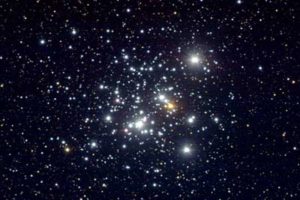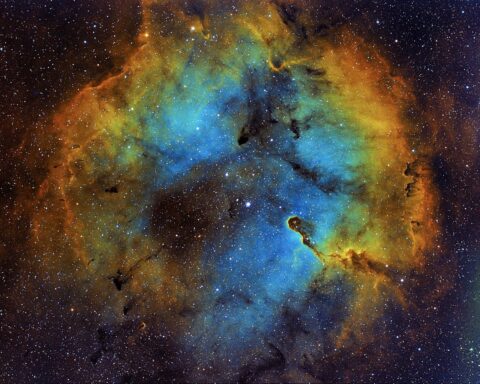A dozen sounds about right:
KISSIMMEE, Fla. (AP) — Clusters of stars on the fringes of our Milky Way galaxy may be home to intelligent life. That’s that word from an astrophysicist who’s new to probing extraterrestrial territory.
Rosanne DiStefano of the Harvard-Smithsonian Center for Astrophysics in Cambridge, Massachusetts, presented her theory Wednesday at the American Astronomical Society’s annual meeting in Kissimmee Florida.
DiStefano said the approximately 150 globular clusters in our galaxy are old and stable, a plus for any civilization. In addition, so many stars are clumped together it would be easy to hop from one place to another, keeping an advanced society going.
She says the first step is to locate more planets in these clusters. So far, only one has been found…

Whether she’s an astrophysicist or not, I’m pretty sure there’s no actual science occurring here. We do not, in fact, know if there’s other life in the universe*. So we really have nothing to base any actual scientific calculations on. I’ll admit, that “old and stable” globular clusters might be a plus. It sounds logical, even reasonable. But how much of a plus? 10%? How much of a plus is meaningful to our unmeasured civilizations? Only 7.5% plus or minus the inverse of the stability? Or does it require 15% minus the age of the youngest star in degrees kelvin? Without measuring any actual civilizations, we can have exactly zero idea. All we can gain is a vague sense of reasonableness about something we know nothing about.**
Where many stars are clumped together, I’ll confess that it might be easy to hop from one planet to another, assuming there were any planets or anyone to do any hopping, neither of which we know. Or it might be very hard – plenty of people are sure we haven’t even hopped to our moon, and we are the most advanced people we ever heard of. But how close is close enough and how easy is easy enough? Again, we have no idea, because we have absolutely nothing real to base our calculations on. Everything must be filled in with guesses, not measurements.
Now sure, this is a just a press report of a speech that has “Study” in the title – so there may or not be an actual study, and there might be some actual science that the reporter chopped because she couldn’t hack the math. And who can argue against the assertion that “Star Clusters Might Host Intelligent Civilizations”? They might. They might also host magic volcanoes that play Pinnacle and belch Justin Bieber blow-up dolls into deep space.
Somebody somewhere might have scienced. But in all likelihood, a young astrophysicist is making a name for herself by creating wish-filled fomulas*** for the sort of people who think Neil deGrasse Tyson is a pretty clever guy, or that lobster tastes better when paid for by the university.
Nice work if you can get it. But not really science, so much.
* Well, we crazy religious people know. By ‘we’ here I mean humans who are certain that all life in the Universe arises from non-life through natural, materialistic processes.
** That used to be called ‘natural philosophy’ before lab coats were invented.
*** Even ‘educated’ guesses, if ultimately based on no data, are mere wishes.










The most concise argument which gets to the key problem in abiogenesis is:
https://www.amazon.com/Evolution-2-0-Breaking-Deadlock-Between/dp/1940363802
The problem is DNA/Ribosomes are a CODE, with an encoder, messages, and decoder, like morse code. There is no known mechanism for these to arise spontaneously. The author has a prize if someone can find a way to create codes ex-nihilo i.e. without a prior intelligence.
It also goes into the errors on both sides of the Creation/Evolution debate – there is real adaptation going on, and cells have mechanisms for adapting. It isn’t random mutation but 5 different things that allow the cell to rewrite its program under stress.
4.5
3.5
5